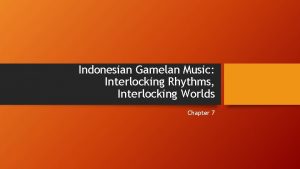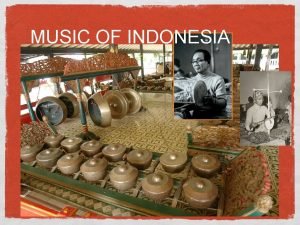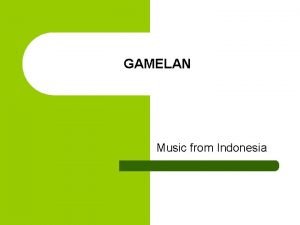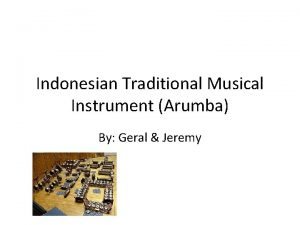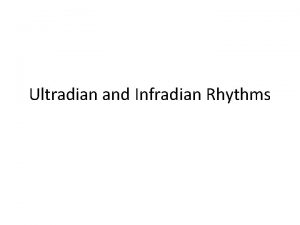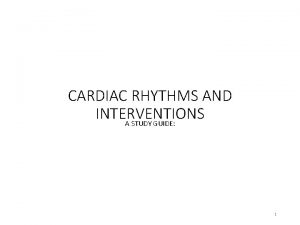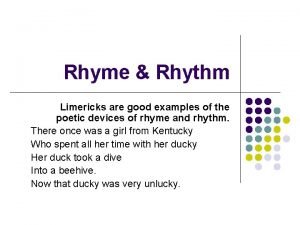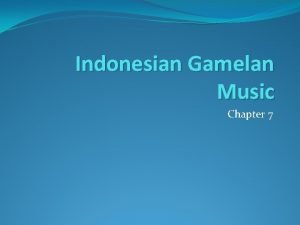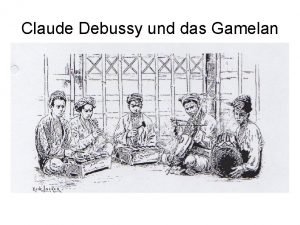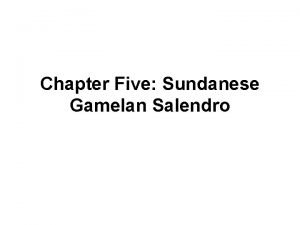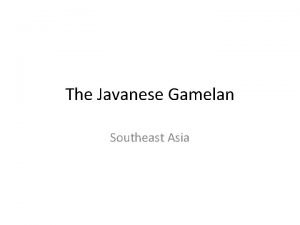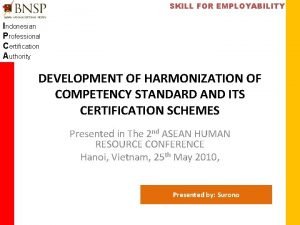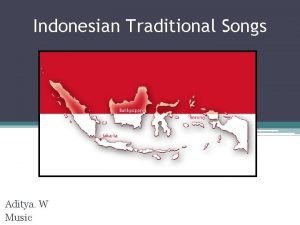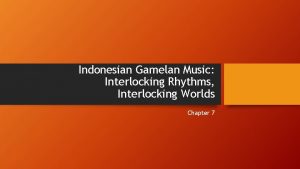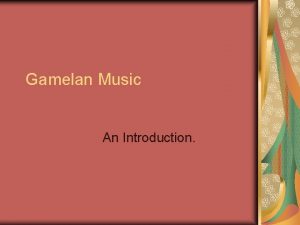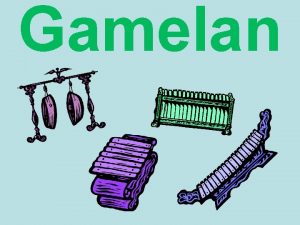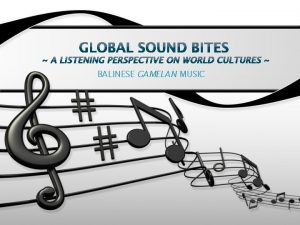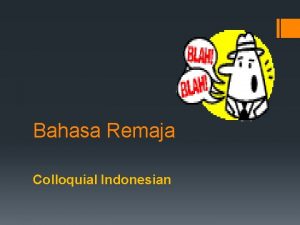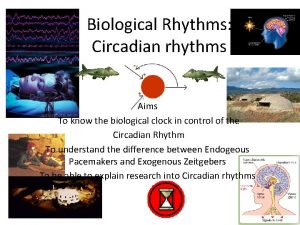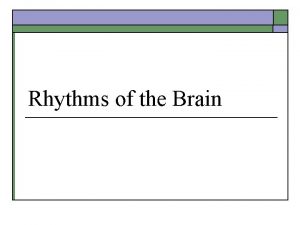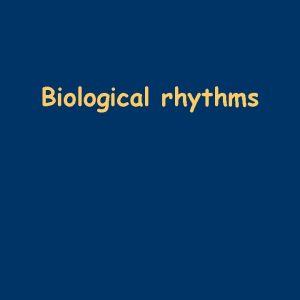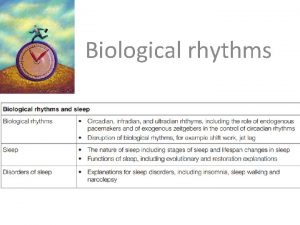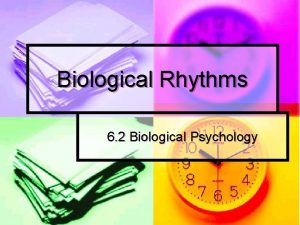Indonesian Gamelan Music Interlocking Rhythms Interlocking Worlds Chapter







![“Ketawang Puspawarna” [PL 7 -8] • Title: • “Ketawang” = a 16 -beat gong “Ketawang Puspawarna” [PL 7 -8] • Title: • “Ketawang” = a 16 -beat gong](https://slidetodoc.com/presentation_image_h/958ba77ea08094b92c190ae5f0496695/image-8.jpg)
![“Taruna Jaya” [PL 7 -9] • Title: Means “Victorious Youth” • Classic early composition “Taruna Jaya” [PL 7 -9] • Title: Means “Victorious Youth” • Classic early composition](https://slidetodoc.com/presentation_image_h/958ba77ea08094b92c190ae5f0496695/image-9.jpg)



![GLE: Beleganjur Music Performed during a Balinese Cremation Procession [PL 7 -12] • 0: GLE: Beleganjur Music Performed during a Balinese Cremation Procession [PL 7 -12] • 0:](https://slidetodoc.com/presentation_image_h/958ba77ea08094b92c190ae5f0496695/image-13.jpg)




![I Wayan Balawan and Batuan Ethnic Fusion, “Country Beleganjur” [PL 7 -25] • Electric I Wayan Balawan and Batuan Ethnic Fusion, “Country Beleganjur” [PL 7 -25] • Electric](https://slidetodoc.com/presentation_image_h/958ba77ea08094b92c190ae5f0496695/image-18.jpg)


- Slides: 20

Indonesian Gamelan Music: Interlocking Rhythms, Interlocking Worlds Chapter 7

Introduction • This chapter explores musical traditions of Indonesian gamelan music, with a particular focus on the gamelan beleganjur, the Balinese “gamelan of walking warriors. ” (p. 90) • Gamelan beleganjur [PL 7 -1] • The term gamelan essentially means “ensemble” or “orchestra. ” • Refers to a diverse class of mainly percussion-dominated music ensembles found on Bali, Java, and several other Indonesian islands. • Related types of ensembles also are found elsewhere in Southeast Asia, for example, in Malaysia and Cambodia.

Balinese Gamelan Music in Context: The Republic of Indonesia • • Southeast Asia 17, 000 islands (close to 6, 000 inhabited) Formerly Dutch East Indies Company (colonized by Dutch) National independence: 1945 (full sovereignty, 1949) • Java • Jakarta (capital) • Surakarta and Yogyarkarta (Central Java – gamelan) • National unity efforts • • Unity in Diversity (slogan) Bahasa Indonesia (language) Cultural nationalism (including gamelan and related arts) Religion • • Islam principal religion of Indonesia (world’s largest and most populous majority-Islamic nation) Hinduism (Agama Tirta) principal religion of Bali

Varied Types of Gamelan Music • Central Javanese court gamelan, “Ladrang Pangkur” [PL 7 -2, “Tjatrik”] • Sundanese gamelan of West Java • Gamelan degung [PL 7 -3] • Gamelan salendro [PL 7 -4] • Jaipongan [PL 7 -5] • Bali • Wayang kulit (music of the shadow-puppet theater) [PL 7 -6] • Gamelan selonding (ancient gamelan of the Bali Aga, indigenous people of Bali) [PL 7 -7]

Balinese and Javanese Gamelan: A Comparison • Comparison of the two best-known types of gamelan from Java and Bali, respectively: • Central Javanese court gamelan (gamelan kraton) • Balinese gamelan gong kebyar • Comparison in the text (pp. 93 -97) is of two of the best-known compositions for these ensembles: • “Ketawang Puspawarna” [PL 7 -8) – Central Javanese court gamelan • “Taruna Jaya” [PL 7 -9] – Balinese gamelan gong kebyar • That comparative discussion is summarized on the next several slides.

General Similarities • Instruments • Gongs, metallophones (gangsa in Bali), drums, end-blown bamboo flutes, bowed chordophones • Cyclic forms (gong cycles) • Related tuning systems, scales, modes • Slendro, pelog (OMI #21) • • Similar polyphony (higher=faster, lower=slower) Melodic layers: core melody, melodic elaboration Hindu basis and related musical symbolism Associations with dance, dance-drama, shadow puppetry (wayang kulit), and other arts

General Differences (pp. 96 -97) Central Javanese Court Gamelan Balinese Gamelan Gong Kebyar Slow, majestic, ethereal Fast, hyper-virtuosic, intense Musically symbolic of subtle, nuanced social interaction ideal Musically symbolic of closely integrated, cooperative community ideal Drumming subtle and understated; one drummer playing multiple drums Drumming fast and prominent; two drummers playing one drum each in fast interlocking patterns Complex multiple-melody textures; “loose” rhythmic treatment Emphasis on intricate melodic interlocking (kotekan); precisely coordinated rhythmic treatment Wide tuning across ensemble Paired tuning between matched sets of instruments; ombak (I&P box, p. 97; OMI #21, #22)
![Ketawang Puspawarna PL 7 8 Title Ketawang a 16 beat gong “Ketawang Puspawarna” [PL 7 -8] • Title: • “Ketawang” = a 16 -beat gong](https://slidetodoc.com/presentation_image_h/958ba77ea08094b92c190ae5f0496695/image-8.jpg)
“Ketawang Puspawarna” [PL 7 -8] • Title: • “Ketawang” = a 16 -beat gong cycle • “Puspawarna” = “flowers of many colors” • Gamelan • Paku Alaman royal palace (kraton) • More than 250 years old • Many different types of instruments with wide range of timbres • Rebab (two-string fiddle) • Kendhang (drums) • Bronze gongs, melodic sets of kettle-gongs, metallophones • Wooden xylophone (gambang), plucked chordophones • Female vocalist, male chorus • Dense, multiple-melody texture, “loose” rhythmic treatment, slow tempo (one 16 -beat gong cycle about 15 seconds, e. g. , 0: 07 -0: 22) • Classic recording from 1971 (included on Voyager Golden Record, 1977)
![Taruna Jaya PL 7 9 Title Means Victorious Youth Classic early composition “Taruna Jaya” [PL 7 -9] • Title: Means “Victorious Youth” • Classic early composition](https://slidetodoc.com/presentation_image_h/958ba77ea08094b92c190ae5f0496695/image-9.jpg)
“Taruna Jaya” [PL 7 -9] • Title: Means “Victorious Youth” • Classic early composition in the kebyar style (c. 1914); was composed to accompany a dance of the same title • Kebyar • Lit. , to burst open (like a flower in bloom), to flare up (like a match) • Name captures the fiery, exciting spirit of the music (also sometimes translated as “lightning”) • Also the name of the exciting, unison opening sections of pieces in this style (e. g. , 0: 000: 42) • Also name of the ensemble (gamelan gong kebyar) • At 0: 42, second part of piece marked by entry of gong cycle • This gong cycle 32 beats (0: 48 -0: 58), and essentially three times faster than its Javanese counterpart! (10 seconds as opposed to 15 seconds, e. g. , 0: 48 -0: 58 • Unfathomably rapid, complex melodic elaboration parts (instruments: gangsa)

Musical Guided Tour: “The Gamelan Beleganjur” • Access at Online Learning Center (OLC): www. mhhe. com/bakan 3 e • Text transcript, pp. 99 -100 • This Tour introduces: • The instruments of the ensemble (know gong ageng, reyong) • The music’s basic gong cycle (i. e. , the recurring sequence of strokes on different gongs that serves as the music’s foundation), which is called gilak. • The relationship between the music’s core melody and the elaboration of that melody in other instrumental parts • The standard rhythms and interlocking rhythmic and melodic patterns (kotekan) employed, especially the kilitan telu patterns of the cymbal parts. • The stratified structure of the music, in which higher-pitched instruments play at faster rates than lower-pitched ones.

Balinese Kecak and the Kilitan Telu • Ubiquitous set of interlocking rhythms in Balinese gamelan • Featured in cymbal (ceng) interlocking in beleganjur • Same set of rhythms (aka cak telu) also used in Kecak dancedrama • • Sanghyang Dedari roots (trance dance of the celestial nymphs) Gamelan suara Ramayana dance-drama (Rama, Sita, Rawana) is context for Kecak Film: Insel der Dämonen (Island of Demons) (1933); Walter Spies • Transferred to melodic interlocking contexts, this same set of rhythms generates intricate melodic tapestries such as those heard in pieces like “Puspanjali” [PL 7 -10] • Kecak (from Baraka film); audio example PL 7 -11

Beleganjur in Balinese Ritual • Agama Tirta (Religion of Holy Water) • Cremation ceremony (ngaben) • Performed by members of the banjar • Purpose: Release soul (atma) to Upper World of Balinese cosmos • Procession of atma to cremation grounds • Multi-tiered cremation tower (wadah), followed by gamelan beleganjur, directed by lead drummer [PL 7 -12] • Gamelan beleganjur functions: • • • Frighten and deflect evil spirits (bhutas, leyaks) Give courage to the atma Energize tower carriers Regulate pace of procession At end, “ladder to Upper World” • Function of the ensemble most important at crossroads. Why?
![GLE Beleganjur Music Performed during a Balinese Cremation Procession PL 7 12 0 GLE: Beleganjur Music Performed during a Balinese Cremation Procession [PL 7 -12] • 0:](https://slidetodoc.com/presentation_image_h/958ba77ea08094b92c190ae5f0496695/image-13.jpg)
GLE: Beleganjur Music Performed during a Balinese Cremation Procession [PL 7 -12] • 0: 00– 0: 35 • Sound of crowd assembling, singing of sacred verses (kidung). • 0: 36– 0: 55 • • • Entry of lead drummer (0: 36), cueing beleganjur ensemble and signaling beginning of procession. Full ensemble enters over gilak gong cycle at 0: 41 (as tower carriers hoist tower onto their shoulders and the procession begins); unison rhythms in cymbals. Brief passage of kilitan telu cymbal interlocking cymbal at end of section (0: 53– 0: 55). • 0: 56– 1: 05 • Gong cycle only (no drums or cymbals), followed by interlocking drumming and return of cymbals. • 1: 06– 1: 38 • Long passage featuring kilitan telu cymbal interlocking. • 1: 39– 1: 49 • Drum duet feature section. • 1: 50–end • Cymbals reenter, more kilitan telu interlocking; excerpt fades out after 2: 05 cymbal crashes as gong cycle continues.

Kreasi Beleganjur • Modern, contest style • Rooted in “warrior ideal” of antiquity • “Baris” (warrior’s dance) [PL 7 -13] • Gerak (choreography) reflects this ideal • Style originated in 1986 • Two of the pioneering composers: Sukarata [PL 7 -14], Asnawa • Exhibitionistic rather than functional • Innovations of kreasi style • • Compositional originality Ensemble virtuosity Showmanship emphasis (including gerak) Varied musical textures

GLE: I Ketut Suandita, “Wira Ghorava Cakti ’ 95, ” Pt. 1 [PL 7 -15] • 0: 00– 0: 06 • Excerpt begins with impressive interlocking drumming, syncopated cymbal rhythms; gilak gong cycle provides foundation. • 0: 07– 0: 18 • Brief passage featuring distinctive, eight-part interlocking cymbal texture (0: 07– 0: 09). • Reyong, drums, and other instruments come in from 0: 10 on. • 0: 19– 0: 27 • Unaccompanied reyong feature (gong cycle drops out); superb example of fast, intricate reyong interlocking. • 0: 28– 1: 14 • Gong cycle returns; talents of full ensemble on display; good examples of more eight-part cymbal interlocking from 0: 38. • Continues on next slide

GLE: “Wira Ghorava Cakti ’ 95, ” Pt. 2 • 1: 15– 1: 28 • Transition to slow-tempoed section of the piece; contrasting musical character. • 1: 29– 2: 11 • Slow section proper begins (over a dramatically slower gilak gong cycle). • Unpredictable and dramatic changes in tempo, texture, and rhythm. • 2: 12–end • Drums and cymbals play at double the tempo of the other instruments, creating an effect of two levels of tempo (slow and fast) occurring at once. • Excerpt fades out as performance continues (3: 00). • Video of same piece performed by 1992 Badung contest champions from Banjar Meranggi, Denpasar

Crossing International Borders • Western composers who have been influenced by/composed for gamelan • • • Janet Jackson, “China Love” [PL 7 -16] Claude Debussy, “Pagodes” [PL 7 -17] John Cage, “Daughters of the Lonesome Isle” (prepared piano) [PL 7 -18] Lou Harrison, Suite for Violin with American Gamelan (4 th mvmt. ) [PL 7 -19] Christine Southworth, “Supercollider” (Gamelan Elektrika, Kronos Quartet [PL 7 -20] • Composers associated with Gamelan Sekar Jaya (Berkeley, CA) • Michael Tenzer, “Unstable Center” [PL 7 -21] • Wayne Vitale, “Khayalan Tiga” [PL 7 -22] • Evan Ziporyn, “Tire Fire: IV” (Gamelan Galak Tika) [PL 7 -23] • Musik Kontemporer (Indonesia) • I Nyoman Windha, I Wayan Sadra, I Komang Astita, I Ketut Gede Asnawa • Book: Radical Traditions, by Andrew Clay Mc. Graw • “Kekembangan, ” by I Nyoman Windha; then collaboratively recreated with Evan Ziporyn [Pl 7 -24]
![I Wayan Balawan and Batuan Ethnic Fusion Country Beleganjur PL 7 25 Electric I Wayan Balawan and Batuan Ethnic Fusion, “Country Beleganjur” [PL 7 -25] • Electric](https://slidetodoc.com/presentation_image_h/958ba77ea08094b92c190ae5f0496695/image-18.jpg)
I Wayan Balawan and Batuan Ethnic Fusion, “Country Beleganjur” [PL 7 -25] • Electric guitar virtuoso, including of double-necked electric guitar and double-necked guitar synthesizer • In “Country Beleganjur, ” standard, single-necked guitar • Piece combines elements of country, bluegrass, funk, jazz, rock, and standard beleganjur music – even a bit of Kecak • See detailed discussion, pp. 112 -13

GLE: Michael Bakan, “B. A. Ph. PET” (Charles Tremblay, turntable soloist; FSU Balinese Gamelan), Pt. 1 [PL 7 -26] PART I • 0: 00– 0: 13 • The four reyong kettle-gongs come in one after the other, together building a dissonant cluster of notes (chord). • Ostinato rhythm is a shortened variant of the basic kilitan telu rhythmic pattern. • 0: 14– 0: 53 • Large gong enters, followed by metallophones (gangsa). • Instruments continue to enter, one by one, gradually filling out the texture with multiple layers and interlocking ostinato parts. • 0: 54– 1: 25 • Synthesizer melody unfolds over a steady, slow-moving core melody in lower-register metallophones. • Sequence of low gong strokes (supplemented by electric bass tones) combines elements of a Balinese-style gong cycle and the bass line of a Western-style chord progression. • Continues on next slide

GLE: “B. A. Ph. PET, ” Pt. 2 PART II • 1: 26– 1: 41 • • All instruments drop out except for a single reyong (like at the beginning). Synthesized drums enter (1: 30). Electric bass enters, establishing funk groove (1: 33). Scratch turntable sneaks in and builds with a crescendo (1: 39– 1: 41). • 1: 42– 3: 37 • Improvised scratch turntable solo—soloist: Charles Tremblay (Note: new bass line begins at 2: 16). • Second, third, and fourth reyong kettle-gongs reenter, one after another, beginning at 2: 29. • All other gamelan instruments gradually reenter, building as before. • 3: 38–end • Return of synthesizer tune over gamelan core melody, low gongs, and electric bass, plus all other instruments; dense, layered, polyphonic texture. • Climax of piece arrives at 3: 55, followed by fade-out ending.
 Kilitan telu
Kilitan telu Gamelan music of indonesia
Gamelan music of indonesia Gamelan music facts
Gamelan music facts Indonesian traditional music
Indonesian traditional music Worlds together worlds apart 4th edition
Worlds together worlds apart 4th edition Music music music
Music music music Outline one or more examples of ultradian rhythms
Outline one or more examples of ultradian rhythms Ekg rhythms and interventions
Ekg rhythms and interventions What is rhythm and rhyme
What is rhythm and rhyme Ekg vt
Ekg vt Esposizione universale parigi 1889 padiglioni
Esposizione universale parigi 1889 padiglioni Kreasi beleganjur
Kreasi beleganjur Gamelan orchester instrumente
Gamelan orchester instrumente Gamelan salendro
Gamelan salendro Three time keeping or punctuating instruments
Three time keeping or punctuating instruments Rwi fred fingers
Rwi fred fingers Shockable and nonshockable rhythms
Shockable and nonshockable rhythms Shockable and nonshockable rhythms
Shockable and nonshockable rhythms Indonesian professional certification authority
Indonesian professional certification authority Ber verbs indonesian
Ber verbs indonesian Indonesian traditional song
Indonesian traditional song
